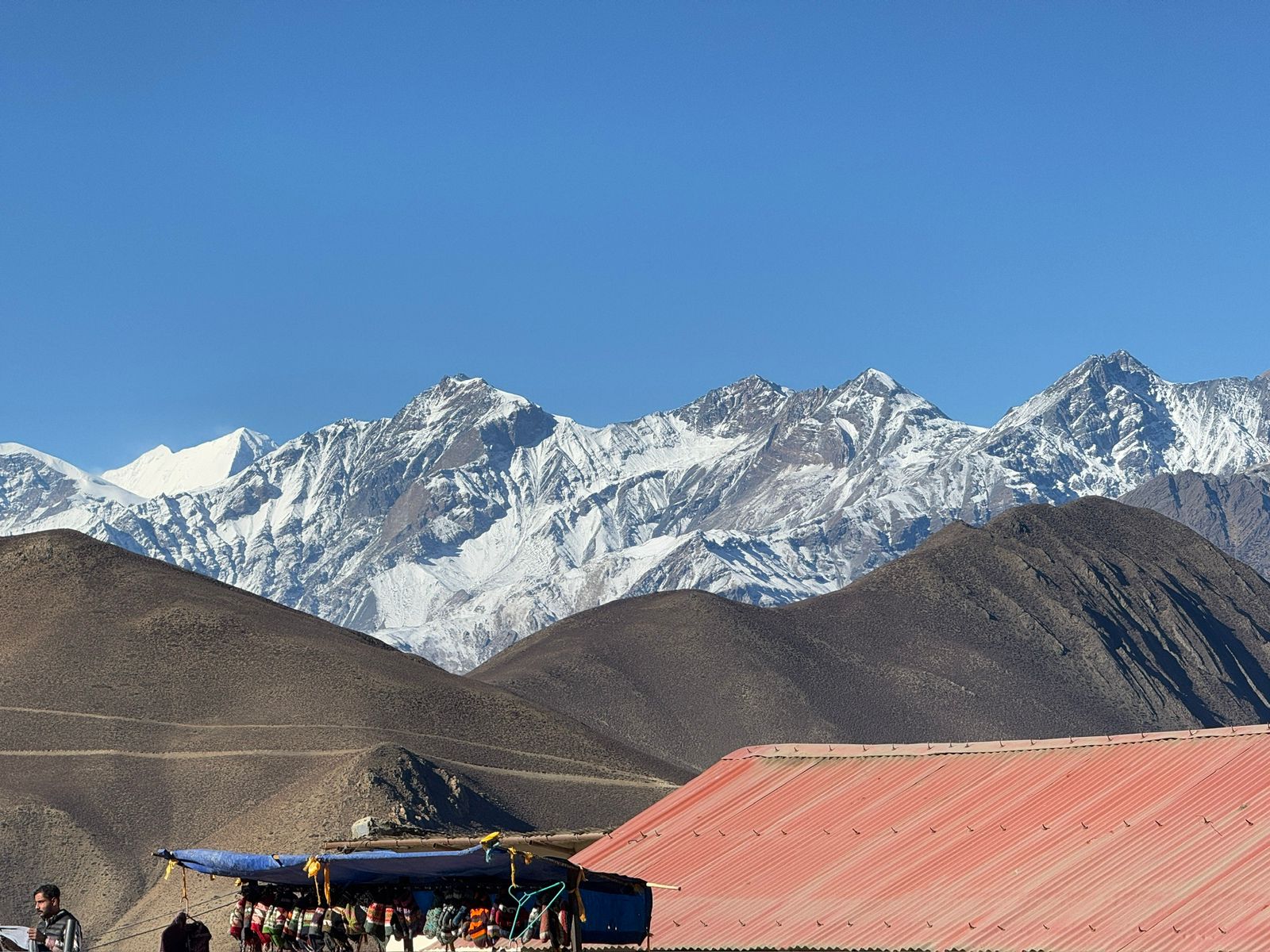
Mustang, often called the “kingdom beyond the mountains” or the “desert of Nepal,” is a land where rugged landscapes and spiritual heritage come together. Known for its barren yet breathtaking terrain, apple orchards, and strong winds, It offers a unique adventure that captivates every traveler. Whether you’re trekking, exploring sacred sites, or immersing yourself in Tibetan culture, It provides a rare and unforgettable experience.
Introduction to Mustang: A Unique Land Beyond the Himalayas
Nestled in the northern region of Nepal, Mustang is known for its isolated beauty. The dry landscape, with no signs of lush greenery, gives the region its desert-like character. However, it’s charm lies not just in its scenery but also in its fascinating combination of apple orchards, ancient caves, and mountainous terrains.
To truly experience the magic of Mustang, a road trip or hike is essential. The journey from Beni to Mustang offers a changing landscape—from rivers and waterfalls to towering cliffs and vibrant village life. This experience offers travelers a glimpse into the evolving culture and nature of the region.
Muktinath Temple: A Sacred Hindu Shrine of Unmatched Significance
The Muktinath Temple is one of Nepal’s most revered Hindu sites. Situated in Lower Mustang, this temple is dedicated to Lord Vishnu and attracts thousands of pilgrims every year. What makes Muktinath especially unique is that its priest is Buddhist and female, symbolizing the harmony that exists between different religions in Mustang.
The temple is encircled by 108 taps, from which freezing water flows. Many believe that bathing in this water can cleanse sins and purify the soul, further amplifying the temple’s importance. The serene surroundings, including snow-capped mountains, add to the sacredness of the site.
Historical and Spiritual Significance of Mustang
It holds great historical and spiritual significance. The region was once the home of Guru Rinpoche (Padmasambhava), the founder of Tibetan Buddhism. As a result, Mustang houses numerous monasteries dedicated to his teachings and practice.
The isolation of Mustang has allowed it to preserve its traditional Tibetan culture, architecture, and customs. Lo Manthang, the walled city, is a prime example of Mustang’s rich spiritual heritage. The ancient monasteries, Tibetan-style houses, and Buddhist rituals in Mustang make it a place where past and present meet.
Dive into the diverse Natural beauty of Nepal.
Trekking and Adventure Opportunities
It is a paradise for trekkers and adventurers, offering various trekking routes that suit all levels of experience.
- Upper Mustang Trek: This trek is an opportunity to experience highlander culture with Tibetan landscapes. The region’s location in the rain shadow of the Himalayas makes it an ideal destination even during the monsoon season. The trek reaches up to 3840 meters, and trekkers can stay in tea houses run by locals, making it a comfortable and accessible journey.
- Muktinath Trek: This trek takes you through serene villages, jungles, and barren landscapes, culminating in the sacred Muktinath Temple. The trek also passes through the Kali Gandaki Gorge, which is considered the deepest gorge in the world.
- Lower Mustang Trek: This route is perfect for year-round trekking. It passes through rhododendron forests, magnolia trees, and traditional villages, making it an enjoyable journey at any time of the year.
- Day Hike to Nepali Grand Canyon: A short hike from Chele leads to the Kali Gandaki River Canyon, a spectacular natural wonder.
Sky Caves and Monasteries: Witness History Carved in Stone
One of the most fascinating aspects of Mustang is its sky caves—ancient caves carved into cliffs. These caves, found in regions like Chhoser, Dhakmar, Chhusang, and Tetang, are believed to have been used by early inhabitants of the region. The Shija Jhong Sky Cave, in particular, is notable for its interconnected rooms and stunning views.
In addition to the caves, Mustang is home to several monasteries, such as Thubchen Monastery and Jampa Monastery, which reflect Tibetan Buddhist architecture. These monasteries serve as centers of meditation, spiritual practices, and community life for the locals.
Why It Should Be on Your Travel List
It is a unique blend of adventure, spirituality, and natural beauty. Whether you’re trekking through its rugged terrains, visiting sacred temples, or exploring ancient caves and monasteries, It offers a truly memorable experience. The spiritual richness, combined with the breathtaking landscapes, makes It one of Nepal’s most remarkable regions to explore.
For support Book By ATTIC INN
FAQs About Mustang
1. What is Mustang known for?
- It is known for its barren landscape, apple orchards, ancient monasteries, and historical significance. It is also famous for the sacred Muktinath Temple.
2. How do I get to Mustang?
- You can reach Mustang by road or trek. The journey from Beni to Mustang is particularly scenic and offers incredible views along the way.
3. What is the best time to visit Mustang?
- The best time to visit is during the autumn (September to November) and spring (March to May) months. The region experiences pleasant weather during these seasons.
4. Can I trek to Upper Mustang in the monsoon?
- Yes, Upper Mustang is in the rain shadow of the Himalayas, making it ideal for trekking during the monsoon season.
5. Is Mustang a safe place to visit?
- Mustang is generally considered safe for tourists. However, it is essential to be mindful of the terrain and weather conditions, particularly when trekking in remote areas.
DEX analytics platform with real-time trading data – https://sites.google.com/walletcryptoextension.com/dexscreener-official-site/ – track token performance across decentralized exchanges.
Privacy-focused Bitcoin wallet with coin mixing – https://sites.google.com/walletcryptoextension.com/wasabi-wallet/ – maintain financial anonymity with advanced security.
Lightweight Bitcoin client with fast sync – https://sites.google.com/walletcryptoextension.com/electrum-wallet/ – secure storage with cold wallet support.
Full Bitcoin node implementation – https://sites.google.com/walletcryptoextension.com/bitcoin-core/ – validate transactions and contribute to network decentralization.
Mobile DEX tracking application – https://sites.google.com/walletcryptoextension.com/dexscreener-official-site-app/ – monitor DeFi markets on the go.
Official DEX screener app suite – https://sites.google.com/mywalletcryptous.com/dexscreener-apps-official/ – access comprehensive analytics tools.
Multi-chain DEX aggregator platform – https://sites.google.com/mywalletcryptous.com/dexscreener-official-site/ – find optimal trading routes.
Non-custodial Solana wallet – https://sites.google.com/mywalletcryptous.com/solflare-wallet/ – manage SOL and SPL tokens with staking.
Interchain wallet for Cosmos ecosystem – https://sites.google.com/mywalletcryptous.com/keplr-wallet-extension/ – explore IBC-enabled blockchains.
Browser extension for Solana – https://sites.google.com/solflare-wallet.com/solflare-wallet-extension – connect to Solana dApps seamlessly.
Popular Solana wallet with NFT support – https://sites.google.com/phantom-solana-wallet.com/phantom-wallet – your gateway to Solana DeFi.
EVM-compatible wallet extension – https://sites.google.com/walletcryptoextension.com/rabby-wallet-extension – simplify multi-chain DeFi interactions.
All-in-one Web3 wallet from OKX – https://sites.google.com/okx-wallet-extension.com/okx-wallet/ – unified CeFi and DeFi experience.

Leave a Reply